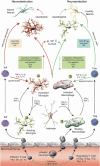A coat of many colors: neuroimmune crosstalk in human immunodeficiency virus infection
- PMID: 19840555
- PMCID: PMC2784686
- DOI: 10.1016/j.neuron.2009.09.042
A coat of many colors: neuroimmune crosstalk in human immunodeficiency virus infection
Abstract
The use of antiretroviral therapy has reduced mortality and increased the quality of life of HIV-1-infected people, particularly in more developed countries where access to treatment is more widespread. However, morbidities continue, which include HIV-1-associated neurocognitive disorders (HAND). Subtle cognitive abnormalities and low-level viral replication underlie disease. The balance between robust antiviral adaptive immunity, neuronal homeostatic mechanisms, and neuroprotective factors on one hand and toxicities afforded by dysregulated immune activities on the other govern disease. New insights into the pathobiological processes for neuroimmune-linked disease and ways to modulate such activities for therapeutic gain are discussed. Better understanding of the complexities of immune regulation during HAND can improve diagnosis and disease outcomes but is also relevant for the pathogenesis of a broad range of neurodegenerative disorders.
Figures


References
-
- Aksenov MY, Aksenova MV, Nath A, Ray PD, Mactutus CF, Booze RM. Cocaine-mediated enhancement of Tat toxicity in rat hippocampal cell cultures: the role of oxidative stress and D1 dopamine receptor. Neurotoxicology. 2006;27:217–228. - PubMed
-
- Anthony IC, Bell JE. The Neuropathology of HIV/AIDS. Int Rev Psychiatry. 2008;20:15–24. - PubMed
Publication types
MeSH terms
Grants and funding
LinkOut - more resources
Full Text Sources
Medical

